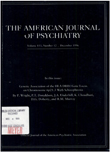Rate and prediction of relapse in bulimia nervosa
Abstract
OBJECTIVE: The purpose of this study was to provide an estimate of the rate of relapse in patients with bulimia nervosa and to attempt to identify indexes of functioning before or after treatment that predicted subsequent relapse. METHOD: The subjects were 48 female patients with bulimia nervosa who achieved symptom control while attending a specialized day hospital treatment program for eating disorders. The subjects were assessed before treatment, after treatment, and at a 2-year follow-up interview with respect to their eating symptoms and psychosocial functioning. RESULTS: A relapse rate of 31% was observed during the 2-year follow-up period, and the vast majority of relapses occurred within the first 6 months after treatment. The strongest predictors of relapse were younger age, higher vomiting frequency, and a higher score on the bulimia subscale of the 26-item Eating Attitudes Test before treatment and higher vomiting frequency and a higher score on the interpersonal distrust subscale of the Eating Disorder Inventory at the end of treatment. Measures of binge eating frequency, self-esteem, depression, and social adjustment were not significant predictors of relapse. CONCLUSIONS: Vomiting frequency, even at subthreshold levels, appears to be an important prognostic indicator and may be one of the best barometers of residual symptoms in these patients.
Access content
To read the fulltext, please use one of the options below to sign in or purchase access.- Personal login
- Institutional Login
- Sign in via OpenAthens
- Register for access
-
Please login/register if you wish to pair your device and check access availability.
Not a subscriber?
PsychiatryOnline subscription options offer access to the DSM-5 library, books, journals, CME, and patient resources. This all-in-one virtual library provides psychiatrists and mental health professionals with key resources for diagnosis, treatment, research, and professional development.
Need more help? PsychiatryOnline Customer Service may be reached by emailing [email protected] or by calling 800-368-5777 (in the U.S.) or 703-907-7322 (outside the U.S.).



